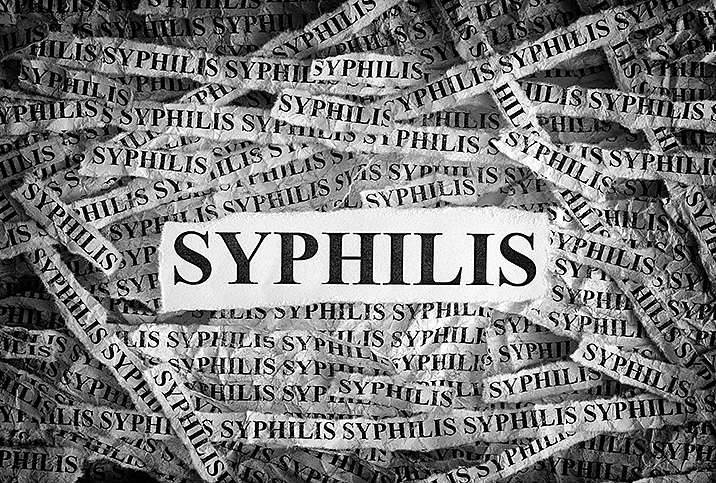The History of Syphilis in the United States

It killed Al Capone and would have killed the husband of Mary Queen of Scots (who wore a mask to hide facial disfigurements caused by the disease) had he not died at 21 in a mysterious explosion. It’s been here a while and unfortunately, it’s still sticking around, and it’s had quite the journey.
Here’s a brief history of syphilis, the notorious "disease of love."
A medical overview
Syphilis is a sexually transmitted disease (STD) caused by the bacterium Treponema pallidum. Over time, it progresses through increasingly unpleasant stages.
A primary (first stage) infection causes painless ulcers on the genitals or mouth, which often go unnoticed. Secondary syphilis can produce a blotchy, red rash on the palms of the hands and soles of the feet and may be accompanied by hair and weight loss, fever, headaches and fatigue. These symptoms clear out on their own and are followed by a latent period, which can last as long as 20 years, during which sufferers exhibit no symptoms whatsoever that they have the disease.
One-third of untreated cases progress to tertiary syphilis, which causes neurological and cardiac problems including numbness, altered behavior, blindness and other sensory deficits, dementia, facial disfigurements (permanent damage to the nose was historically common) and paralysis.
Ultimately, it can be fatal.
The discovery of syphilis
For a disease shrouded in stigma, it’s perhaps fitting that even its origins are highly contested.
Radiocarbon dating has detected syphilis-attributed lesions on skeletons from several thousand years ago. Some researchers (but not all) suggest Columbus and his crew introduced it to the indigenous peoples of North America in the 15th century. It is clear syphilis was widespread in Europe by 1495, when a mass outbreak swept across the continent, possibly originating among the French armies of Charles VIII when he invaded Naples at the start of the Italian Wars.
By the early 1900s, syphilis was among the leading morbidities in the United States, with no connected cause or effective treatment. The social stigma was rife—it was termed the disease of "bad blood," assumed to afflict only adulterers and prostitutes—and many who had it were ostracized or disgraced.
Finding a treatment
For centuries, syphilis sufferers were forced to endure horrific (and unsuccessful) treatments.
Mercury was the primary method utilized to burn away lesions, available first as an elixir, and later as an ointment, steam, bath or pill. However, not only was mercury ineffective as a cure, it caused horrific side effects, including tooth loss, severe ulceration, neurological damage and mercury poisoning, which in itself was often deadly. Other unscientific remedies ranged from guaiacum—also known as the Holy Wood from the New World—to sweat baths.
It wasn’t until 1905 that Fritz Schaudinn and Erich Hoffman identified the bacteria behind the disease. Five years later, the first effective therapy, Salvarsan, was developed by Nobel Prize winner Paul Ehrlich (his famous 'magic bullet'). Unfortunately, Salvarsan, too, came with horrible side effects although this was unsurprising, perhaps, considering it was derived from arsenic.
While penicillin had been discovered by Alexander Fleming in 1928, it didn’t become widely available around the globe for decades. In 1932, the unethical Tuskegee syphilis study began in the United States: To summarize briefly, it evaluated the long-term effects of untreated syphilis by withholding treatment from African-American men with the disease.
In 1943, penicillin was introduced as a cure for syphilis and by 1947, it became the first line of treatment. While the vast majority of bacteria today are no longer treatable with this traditional, widely-used drug, T. pallidum remains susceptible.
Currently, treating syphilis is as simple as a shot of our oldest antibiotic.
Syphilis resurgence
With the discovery and implementation of a genuine cure, syphilis rates began to decline in the U.S. after a peak in the late 1940s. Prevalence of the infection continued to slowly decline during the next half-century, except for an uptick in cases in the late 1980s and early ’90s, associated with a rise in crack cocaine use among gay men. Syphilis rates dropped promisingly afterward, supported by significant public health efforts, hitting all-time lows at the end of the millennium: In 2000, national syphilis rates were 2.1 cases per 100,000 Americans, the lowest rate since 1941.
However, the disease was not eradicated, and rates began climbing again swiftly after 2013, and by 2019 rates had risen to those not seen since the 1940s. New research suggests a link to co-occurrence with another dangerous STD—a shocking 41.6 percent of HIV-positive gay men have primary or secondary syphilis. Increased rates of illicit drug use, unprotected sex and sex with multiple partners are additional factors perpetuating this spread.
The continuous rise in sexually transmitted diseases in the U.S. population remains concerning for public health officials, resulting in a new wave of awareness campaigns to encourage surveillance, testing and treatment.
Nonetheless, a diagnosis of syphilis is no longer (or certainly, should not be) the stigma that it was for centuries, and thanks to Fleming, the cure is just a jab away.


















